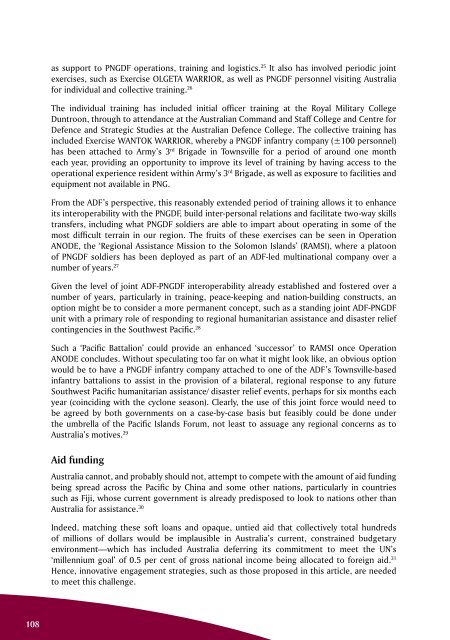190%202013%20Mar_Apr
190%202013%20Mar_Apr
190%202013%20Mar_Apr
Create successful ePaper yourself
Turn your PDF publications into a flip-book with our unique Google optimized e-Paper software.
108<br />
as support to PNGDF operations, training and logistics. 25 It also has involved periodic joint<br />
exercises, such as Exercise OLGETA WARRIOR, as well as PNGDF personnel visiting Australia<br />
for individual and collective training. 26<br />
The individual training has included initial officer training at the Royal Military College<br />
Duntroon, through to attendance at the Australian Command and Staff College and Centre for<br />
Defence and Strategic Studies at the Australian Defence College. The collective training has<br />
included Exercise WANTOK WARRIOR, whereby a PNGDF infantry company (±100 personnel)<br />
has been attached to Army’s 3 rd Brigade in Townsville for a period of around one month<br />
each year, providing an opportunity to improve its level of training by having access to the<br />
operational experience resident within Army’s 3 rd Brigade, as well as exposure to facilities and<br />
equipment not available in PNG.<br />
From the ADF’s perspective, this reasonably extended period of training allows it to enhance<br />
its interoperability with the PNGDF, build inter-personal relations and facilitate two-way skills<br />
transfers, including what PNGDF soldiers are able to impart about operating in some of the<br />
most difficult terrain in our region. The fruits of these exercises can be seen in Operation<br />
ANODE, the ‘Regional Assistance Mission to the Solomon Islands’ (RAMSI), where a platoon<br />
of PNGDF soldiers has been deployed as part of an ADF-led multinational company over a<br />
number of years. 27<br />
Given the level of joint ADF-PNGDF interoperability already established and fostered over a<br />
number of years, particularly in training, peace-keeping and nation-building constructs, an<br />
option might be to consider a more permanent concept, such as a standing joint ADF-PNGDF<br />
unit with a primary role of responding to regional humanitarian assistance and disaster relief<br />
contingencies in the Southwest Pacific. 28<br />
Such a ‘Pacific Battalion’ could provide an enhanced ‘successor’ to RAMSI once Operation<br />
ANODE concludes. Without speculating too far on what it might look like, an obvious option<br />
would be to have a PNGDF infantry company attached to one of the ADF’s Townsville-based<br />
infantry battalions to assist in the provision of a bilateral, regional response to any future<br />
Southwest Pacific humanitarian assistance/ disaster relief events, perhaps for six months each<br />
year (coinciding with the cyclone season). Clearly, the use of this joint force would need to<br />
be agreed by both governments on a case-by-case basis but feasibly could be done under<br />
the umbrella of the Pacific Islands Forum, not least to assuage any regional concerns as to<br />
Australia’s motives. 29<br />
Aid funding<br />
Australia cannot, and probably should not, attempt to compete with the amount of aid funding<br />
being spread across the Pacific by China and some other nations, particularly in countries<br />
such as Fiji, whose current government is already predisposed to look to nations other than<br />
Australia for assistance. 30<br />
Indeed, matching these soft loans and opaque, untied aid that collectively total hundreds<br />
of millions of dollars would be implausible in Australia’s current, constrained budgetary<br />
environment—which has included Australia deferring its commitment to meet the UN’s<br />
‘millennium goal’ of 0.5 per cent of gross national income being allocated to foreign aid. 31<br />
Hence, innovative engagement strategies, such as those proposed in this article, are needed<br />
to meet this challenge.


